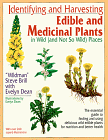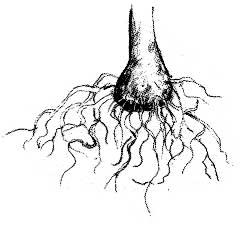|
|
 Identifying and Harvesting Edible and Medicinal Plants in
Wild (and Not So Wild) Places Identifying and Harvesting Edible and Medicinal Plants in
Wild (and Not So Wild) PlacesBy: "Wildman"
Steve Brill
Book Excerpt: ROOTS
Things we don’t normally consider fruits (nuts, seeds, and pods) are fruits after
all, but underground plant parts we call roots really aren’t always true roots.
Rhizomes, for example, are horizontal underground
stems that give rise to true roots, and to above-ground
shoots. They may form dense colonies, like cattails, so
colonies indicate that the plants are connected by
underground rhizomes. Some rhizomes, like Solomon’s
seal’s, store food underground.

Rhizome
Some rhizomes, like the ground nut’s, also produce
tubers along their lengths. These short, thick sections
of underground stems usually bear minute buds—the
familiar eyes of potatoes—that can grow into new
plants. Tubers also store food, and many are edible.

Tuber
A bulb is a single, large, roundish bud, consisting of
a
short stem surrounded by layers of underground,
scale-like leaves. Onions and garlic are typical. Bulbs
often store food, and many are edible.

Bulb
Corms are short, upright, thickened underground stems
also specialized for food storage. They’re not layered
like onions, nor attached to rhizomes or bearing buds
like tubers. Sometimes they’re edible, but they don’t
provide any major wild foods in the United States.

Corm
Taproots are true roots. The form from the primary
root—the first root that emerges from the seed.
They’re usually large and vertical, with branches.
Many, like burdock and common evening primrose,
store food.

Taproot
Fibrous roots look like they sound. These true roots
are
tangled masses of wiry fiber. Most are not edible or
medicinal. They hold the soil together, keep out other
plants, and often hamper you from digging up other
roots.

Fibrous Root
Edible roots are usually in season from fall to early
spring, when they store food for spring growth. You
can even collect them in the winter, if it’s warm
enough that the ground doesn’t freeze, and the basal
rosettes that mark the roots’ locations still grow. By
midspring, most roots relinquish their stored food and
become tough and woody, although exceptions such as
burdock and ground nuts are edible all year.
________________________________________________
Click here to visit Steve's Web Site |
